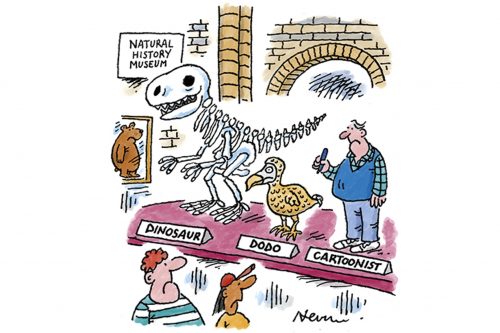JAM Bookshop RIP

Glenn Marshall writes: Sadly one of our duties on the blog is to write obituaries – this one is for a book store. The wonderful and inspiring JAM Bookshop in Hackney, run by the cartoonist and illustrator David ‘Ziggy’ Greene, closes its doors for the final time on Sunday. It really was a lovely and […]
Why does no one want to be a cartoonist any more? The lack of new blood doesn’t bode well for the industry’s future

Written by Nick Newman for (and courtesy of) The Spectator with bonus cartoon content. ‘Nightmare!’ is how The Spectator’s cartoon editor Michael Heath has been describing cartooning for at least 30 years, but it’s truer now than ever. Eighty years ago, cartoonists were so celebrated that waxworks of Low, Strube and Poy were displayed in […]
Tomi Ungerer – ‘Expect the unexpected’
Glenn Marshall writes: I’m easily influenced by all sorts of things around me, as Tomi Ungerer said ‘I’ve always been a sponge, just absorbing whatever I see, whether it’s in daily life or in art’, and Ungerer, who sadly died last week, was particularly inspiring and influencial to me. I love his varied, playful and boundary-pushing […]
PCO Cartoon Review of 2017
Everyone else is doing it so we thought we’d have our own look back at the year…with cartoons by PCO members. The Big Issue drawing above by Andrew Birch manages to fit the whole year into just one cartoon! © Ralph Steadman We started the year with Trump’s bigly attended inauguration. Trump was undoubtedly (Mad) Man of the […]
The Round-up
The cartoon above, by Peter Steiner, is understood to be the most popular ever to appear in The New Yorker. Journalist Glenn Fleishman talks to its creator and looks at what has happened in the 20 years since it first appeared. Last Friday’s edition of The One Show dropped in on a host of […]
The Round-up
George Grosz, the German satirical artist who has inspired so many of today’s cartoonists, is the subject of a new exhibition at the Richard Nagy gallery in London – the first retrospective of Grosz’s work to be held in the UK for almost 20 years. Read more about the show here. Matt Pritchett of The […]
The Round-up
Above: Cartoon editor Bob Mankoff on the anatomy of a New Yorker cartoon. Over at New Yorker HQ, Mankoff’s blog features a guest column about using cartoon captions in the classroom. Several months after taking The Dandy purely digital, DC Thomson has suspended its existing app, saying that “the technology and format have let us […]
The Round-up
The Premier League was rocked this week by the unexpected news of Sir Alex Ferguson‘s retirement, and cartoonists had a ball with it (sorry). In The Telegraph, Christian Adams put the news in context (above), while Matt Pritchett drew parallels with another recent shock resignation. Over in The Guardian, Kipper Williams considered the impact on […]
The Round-up
Bruce Eric Kaplan, the cartoonist and TV writer who signs his distinctive New Yorker cartoons as BEK (above), tells Co.Create about how day-to-day frustrations lead to many of his best ideas. Read the interview and see a selection of BEK’s work here. (Thanks to cartoonist Mike Lynch for the link.) British comics artist Lew […]
